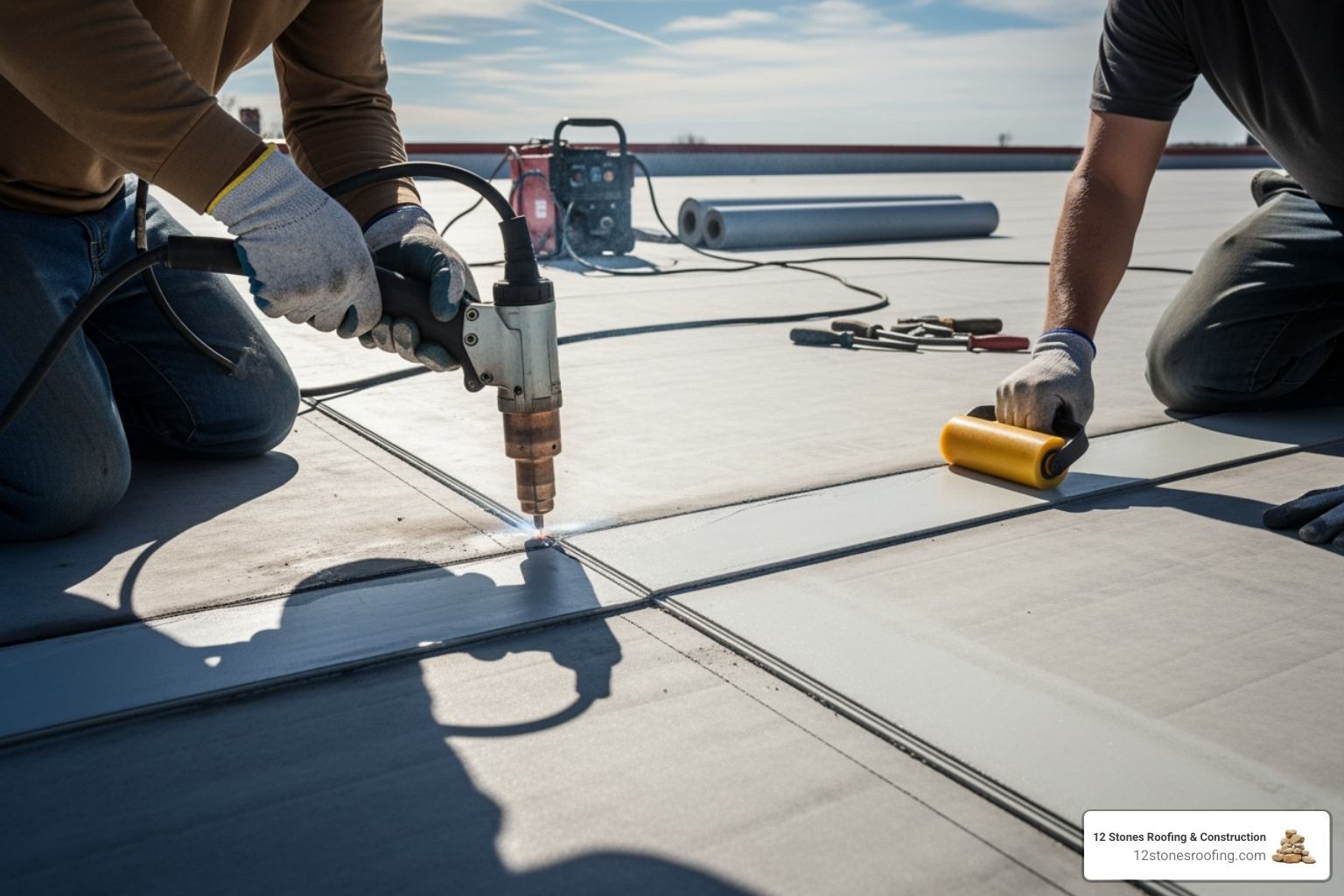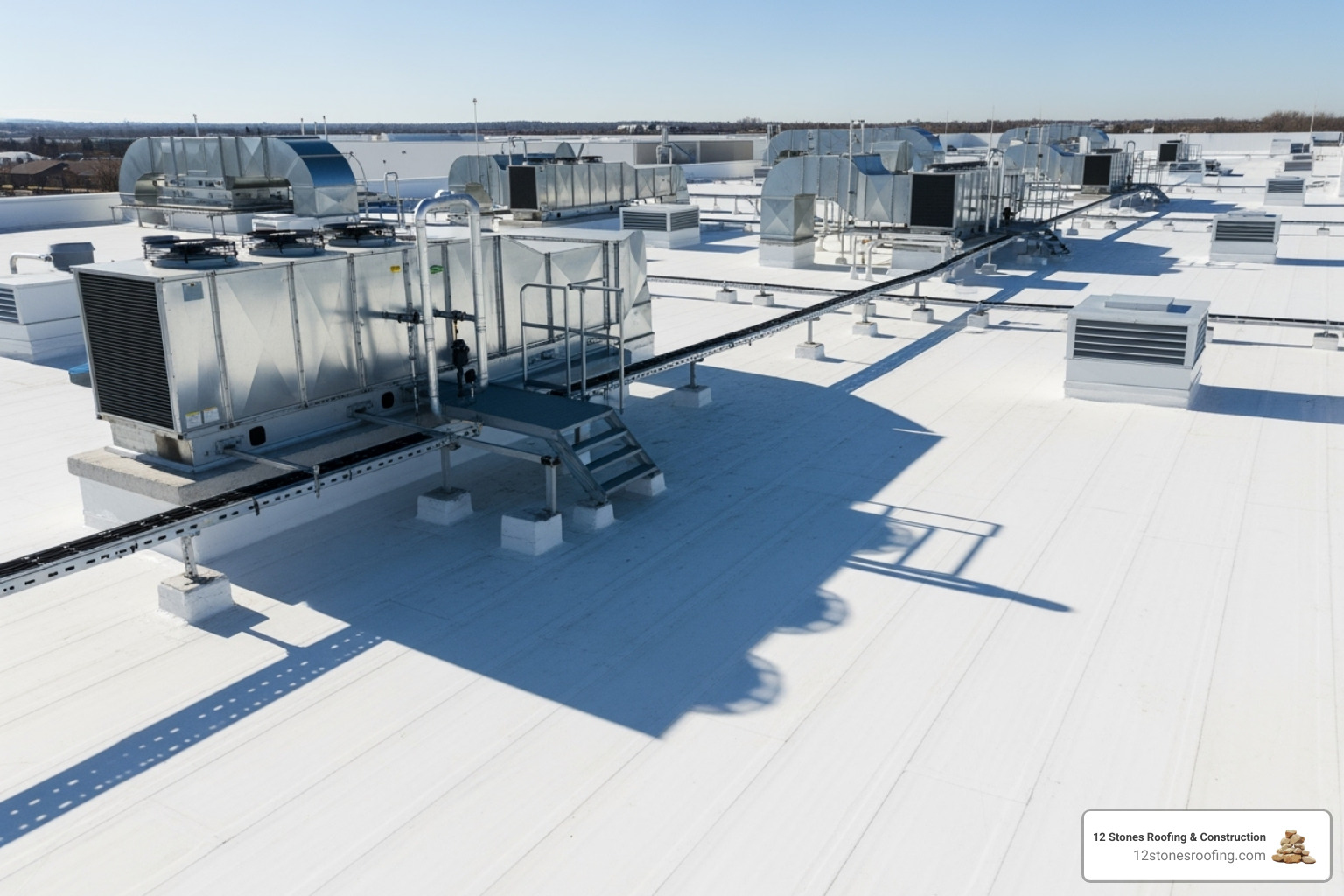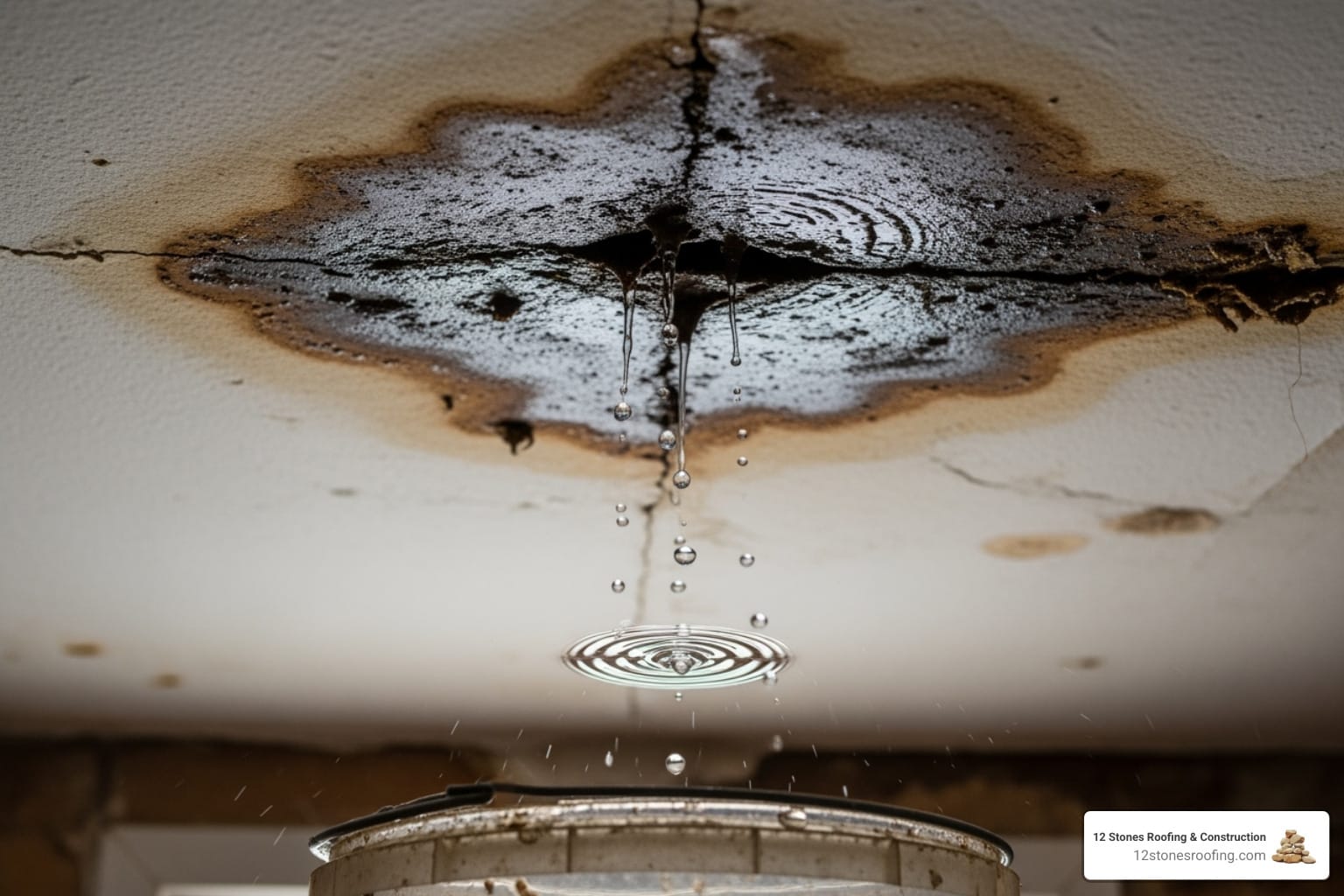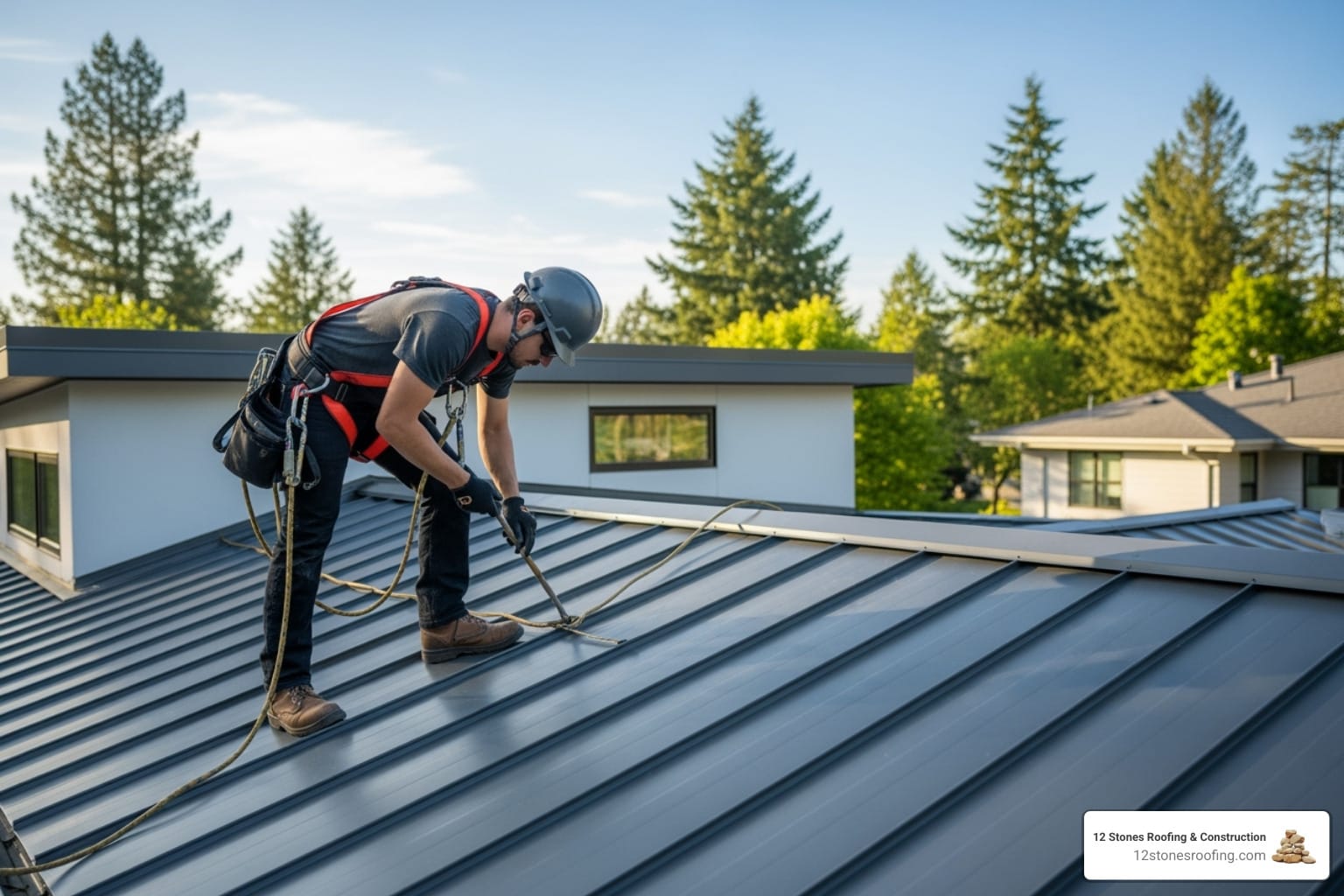Why Flat Roof Material Types Matter for Texas Properties
Flat roof material types include single-ply membranes like EPDM, TPO, and PVC, as well as multi-layered systems such as Built-Up Roofing (BUR) and Modified Bitumen. Each offers distinct advantages in durability, cost, and climate suitability. Choosing the right one is critical for performance and longevity, especially in Texas’s demanding climate. For expert advice and installation, property owners trust the professionals at 12 Stones Roofing & Construction, your local flat roofing experts.
Quick Comparison of Common Flat Roof Material Types:
| Material | Lifespan | Cost/Sq Ft | Best For |
|---|---|---|---|
| EPDM (Rubber) | 25-50 years | $4-$13 | Budget-conscious, large commercial roofs |
| TPO | 20-30 years | $4-$14 | Hot climates, energy efficiency |
| PVC | 20-30+ years | $4-$12 | Chemical resistance, high foot traffic |
| Built-Up (BUR) | 20-30 years | $4-$10 | Maximum durability, industrial use |
| Modified Bitumen | 15-20 years | $4-$8 | Residential additions, small projects |
Flat roofs provide a modern look and maximize usable space, but their low slope makes them vulnerable to water ponding, UV degradation, and storm damage. In Texas, where extreme heat, heavy rain, and high winds are common, a poorly chosen material can lead to premature failure and costly repairs. The lifespan of a flat roof ranges from 20 to 50 years, making the initial material selection a crucial long-term investment.
This guide breaks down the most common flat roof material types, covering their pros, cons, costs, and ideal applications. Whether you’re planning a new installation or a replacement, this resource will help you make an informed decision for your Texas property.

The Main Contenders: Single-Ply Membrane Roofing Systems
Single-ply membranes are a modern advancement in flat roof material types. These factory-manufactured sheets of synthetic material are installed in a single layer, creating a seamless, watertight barrier. Engineered for durability, flexibility, and energy efficiency, they are a popular choice for commercial and residential properties in Texas, offering strong performance in harsh weather and the potential for significant cooling cost reductions.
Let’s explore the three main types of single-ply membranes.
EPDM (Rubber Roofing): The Proven, Long-Lasting Choice
EPDM (Ethylene Propylene Diene Monomer) is a synthetic rubber membrane known for its exceptional durability, often called the workhorse of flat roofing.
- Lifespan: EPDM rubber roofing can last up to 50 years, making it one of the longest-lasting single-ply options.
- Cost: EPDM typically runs between $4 and $13 per square foot installed.
- Key Features: The material remains flexible in fluctuating temperatures, preventing cracks. It comes in large rolls, which minimizes seams and potential leak points.
- Pros: Superior longevity, cost-effective for large roofs, proven performance over decades.
- Cons: The standard black color absorbs heat, potentially increasing cooling costs. It can be punctured by sharp objects, though repairs are generally simple.
- Best For: Budget-conscious projects, large warehouses, and industrial buildings where long-term durability is the top priority.
TPO Roofing: The Energy-Efficient Flat Roof Solution
TPO (Thermoplastic Olefin) is an energy-saving superstar, especially in hot climates like Texas. Its brilliant white surface reflects solar rays, keeping buildings cooler.
- Lifespan: TPO typically lasts between 20 and 30 years.
- Cost: The cost ranges from $4 to $14 per square foot installed.
- Key Features: A study by Lawrence Berkeley National Laboratory found that reflective roofs like TPO can reduce cooling energy use by 10-30%. Its seams are heat-welded to form a monolithic, watertight barrier that is as strong as the membrane itself.
- Pros: Excellent energy efficiency, strong seam technology, good resistance to punctures and UV radiation.
- Cons: Quality can vary between manufacturers, so choosing a reputable brand is crucial.
- Best For: Commercial buildings, retail spaces, and any property where reducing cooling costs is a priority. Its reflective surface also complements solar panel installations.

PVC Roofing: The Heavy-Duty, Chemical-Resistant Performer
PVC (Polyvinyl Chloride) is the premium option among single-ply flat roof material types, delivering superior performance for demanding environments.
- Lifespan: PVC roofing systems typically last 20 to 30 years or longer.
- Cost: PVC runs between $4 and $12 per square foot installed.
- Key Features: Like TPO, PVC is reflective and has heat-welded seams. Its defining feature is exceptional resistance to chemicals, fire, grease, and oils. It also handles foot traffic better than other single-ply options.
- Pros: Outstanding chemical and fire resistance, high durability, ideal for high-traffic roofs.
- Cons: Higher upfront cost compared to other single-ply materials.
- Best For: Restaurants, food processing plants, industrial facilities, and any roof with heavy equipment or frequent foot traffic.

Traditional Flat Roof Material Types: Multi-Layered Protection
Before single-ply membranes, traditional multi-layer systems were the standard for commercial roofing. These time-tested flat roof material types rely on a redundant layering approach, where multiple protective barriers work together to keep water out. While modern materials offer sleek efficiency, these traditional systems remain a viable choice, particularly where maximum durability is the primary goal.
Built-Up Roofing (BUR): The Classic Multi-Layer System
Built-Up Roofing (BUR), also known as a “tar and gravel” roof, is one of the oldest and most trusted flat roofing methods.
- Lifespan: A well-installed BUR system provides 20 to 30 years of service.
- Cost: Installation typically runs $4 to $10 per square foot.
- Construction: Roofers build the system on-site with alternating layers of hot asphalt (bitumen) and reinforcing fabrics. This multi-ply “sandwich” is topped with a layer of gravel or crushed stone.
- Pros: The multiple layers create exceptional waterproofing. The gravel surface offers outstanding UV, fire, and hail protection and stands up well to foot traffic.
- Cons: BUR systems are very heavy, requiring a robust roof structure. The installation process involves hot asphalt, which creates strong odors. Leak detection can also be difficult.
- Best for: Heavy-duty industrial buildings, facilities with frequent rooftop access, and properties where maximum durability and fire resistance are non-negotiable.

Modified Bitumen: The Flexible Asphalt-Based Solution
Modified Bitumen is an evolution of BUR, representing a more flexible, modern asphalt-based roofing system.
- Lifespan: Modified Bitumen systems typically last 15 to 20 years.
- Cost: Installation costs range from $4 to $8 per square foot, making it one of the most budget-friendly options.
- Construction: This system uses asphalt modified with polymers (like APP or SBS) to improve flexibility and prevent cracking. It comes in rolls and can be installed using a torch-down method, cold adhesives, or self-adhered systems. Many products feature a “cool roof” reflective mineral surface.
- Pros: The polymer modification provides excellent flexibility to handle temperature changes. It offers good tear resistance and is one of the most affordable flat roof material types.
- Cons: It generally has a shorter lifespan than premium single-ply systems. The torch-down application method requires an experienced professional to avoid fire hazards.
- Best for: Residential low-slope additions, detached garages, and small to mid-sized commercial roofs where budget is a primary concern.
Key Factors for Choosing Flat Roof Material Types in Texas
Selecting the right flat roof material types in Texas is not a one-size-fits-all decision. The state’s unique climate, combined with your building’s specific needs and budget, must be carefully considered to avoid costly repairs or premature replacement.
Climate & Weather: How Texas Conditions Impact Flat Roofs
Texas weather presents a relentless combination of challenges for any roofing system.
- Extreme Heat: The sun’s UV rays can degrade materials over time. Dark roofs absorb heat, driving up cooling costs. White, reflective TPO and PVC roofs are ideal for Texas, as they can reduce cooling energy use by 10-30%, according to research from Lawrence Berkeley National Laboratory. The NYC CoolRoofs program has documented similar savings.
- Heavy Rain and Wind: Flat roofs are vulnerable to water intrusion. Systems with heat-welded seams (TPO, PVC) create a monolithic barrier against leaks. Heavy BUR systems offer exceptional wind uplift resistance. Proper drainage is critical to prevent ponding water, which accelerates deterioration.
- Hail Damage: Hail can puncture or crack roofing materials. Impact resistance is a key consideration. BUR systems with thick gravel layers and certain impact-resistant modified bitumen or single-ply products offer improved protection.
Our Pasadena, TX roofing team specializes in selecting materials engineered to withstand local weather patterns.
Comparing Cost, Lifespan, and Maintenance
A smart decision balances upfront cost with long-term performance and maintenance needs. A cheap material that fails early is no bargain.
| Material | Average Cost/Sq. Ft. | Typical Lifespan | Maintenance Level | Energy Efficiency |
|---|---|---|---|---|
| EPDM (Rubber) | $4.00 – $13.00 | 25-50 years | Low | Moderate |
| TPO | $4.00 – $14.00 | 20-30 years | Low | High |
| PVC | $4.00 – $12.00 | 20-30+ years | Low | High |
| Built-Up (BUR) | $4.00 – $10.00 | 20-30 years | Moderate | Moderate (with gravel) |
| Modified Bitumen | $4.00 – $8.00 | 15-20 years | Moderate | Moderate (reflective options available) |
While Modified Bitumen has a low entry cost, EPDM offers exceptional longevity. TPO and PVC may cost more upfront, but their energy efficiency provides a return on investment through lower cooling bills over the roof’s lifespan.
Maintenance is non-negotiable for all flat roof material types. Semi-annual inspections, debris removal, and drain cleaning are essential to prevent ponding water and catch small issues before they become major problems. A proactive roof maintenance checklist can add years to your roof’s life.
Building Use, Budget, and Long-Term Value
The best material choice aligns with your building’s function and financial goals.
- Building Use: A restaurant needs PVC’s grease and chemical resistance. A large warehouse may be perfectly served by cost-effective EPDM. Roofs with heavy foot traffic or HVAC equipment benefit from durable materials like PVC or BUR.
- Budget & Lifecycle Cost: Think beyond the initial invoice. Energy-efficient TPO and PVC can save thousands in cooling costs over their lifespan, justifying a higher upfront investment. A more durable material that lasts longer is often the better financial choice.
- Long-Term Value: This is a combination of durability, lifespan, and warranty coverage. A strong manufacturer and workmanship warranty provides peace of mind and protects your investment.
If budget is a concern, we can help. We offer flexible financing options to help you invest in the right material without straining cash flow.
Ask about our flexible roof financing options.
Frequently Asked Questions About Flat Roof Material Types
Property owners often have questions when choosing between flat roof material types. Here are answers to the most common inquiries we receive from clients in the Houston area.
What is the longest-lasting flat roof material type?
EPDM rubber roofing is the longest-lasting flat roof material, with a typical lifespan of 25 to 50 years. Some well-maintained EPDM roofs have been documented to last even longer. Metal roofing can also achieve lifespans of 50+ years but is more common on low-slope rather than true flat roofs. The actual lifespan of any material depends heavily on installation quality, climate, and consistent maintenance.
Which flat roof material type is the most cost-effective?
Modified Bitumen and Built-Up Roofing (BUR) generally have the lowest upfront installation costs, ranging from $4 to $10 per square foot. However, the most cost-effective choice considers long-term value. TPO and PVC systems, while sometimes more expensive initially, deliver significant energy savings in hot climates. According to Lawrence Berkeley National Laboratory, their reflective surfaces can reduce cooling costs by 10-30%, which can amount to thousands of dollars in savings over the roof’s life, making them a smarter long-term financial decision. Ask about our flexible roof financing options to make the best long-term choice more accessible.
Can you install a new flat roof over an old one?
While sometimes possible, installing a new roof over an old one (a “roof-over”) is generally not recommended. This practice can trap moisture, leading to rot and mold, and the added weight can strain your building’s structure. Crucially, most manufacturers will void their material warranties if their product is installed over an existing roof. A complete tear-off and professional flat roof installation is the best practice. This allows for inspection of the roof deck and ensures a clean, stable foundation for the new system, protecting your investment and ensuring full warranty coverage.
Trust 12 Stones Roofing & Construction for Your Flat Roof Installation
Choosing the right flat roof material types is only half the battle; the success of any system depends on expert installation. Even the highest-quality material will fail prematurely if not installed correctly. At 12 Stones Roofing & Construction, our team has mastered the nuances of every major flat roof system.
We understand that precision matters in every detail, from proper substrate preparation and meticulous seam sealing to ensuring adequate drainage. Our certified installers follow strict manufacturer specifications, which is crucial for protecting your warranty and ensuring your roof performs as designed.
When you work with us, you get a partner who evaluates your building’s structure, local weather patterns, and long-term goals to recommend the material that delivers the best value. We believe in transparent, honest service for our clients in Pasadena and the greater Houston area. Our commitment is to deliver a durable, leak-free roof built to withstand Texas weather.
Ready to get started?
Request your free flat roofing estimate and expert consultation.





